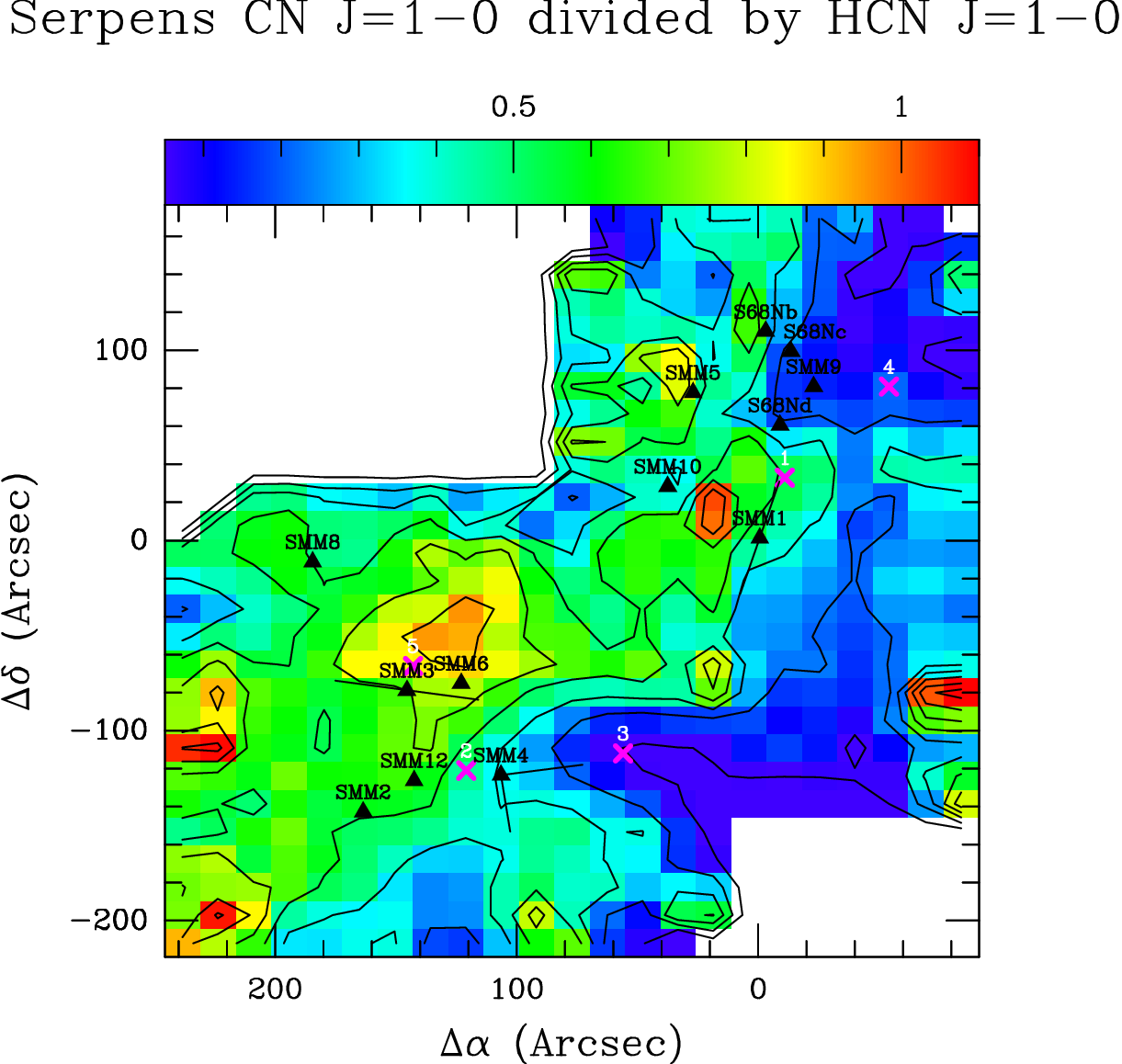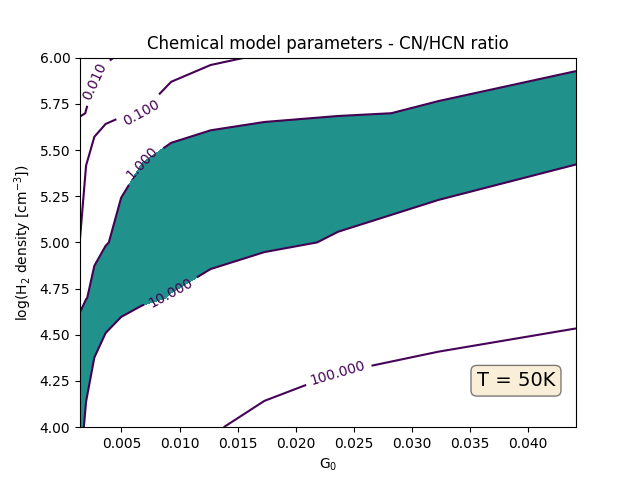Astronomy Object of the Month: 2019, July
< previous Archive next >
Signatures of UV radiation around low-mass protostars in Serpens
A new-born protostar forms in dense core deep inside molecular cloud.
Molecular cloud is characterised by high extinction in the optical
range so observations at long wavelengths are necessary. In particular, submillimetre spectra include
rotational lines of key molecules which are useful tracers
of physics and chemistry around low-mass protostars. The column densities of HCN and CN molecules can be determined with the RADEX radiative
transfer code. This information can be compared with an astrochemical model in order to characterise the strength of the UV radiation. Thus,
we gain new understandings of chemical and physical processes around low-mass protostars.

Illustration 1: Emission of the CN/HCN in the Serpens Main region. Black triangles show the positions of the protostars, whereas black lines show the associated outflow directions. Outflow positions are displayed as purple crosses. Credit: The Authors

Illustration 2: Contour plot of Nahoon sets of models of CN/HCN abundances ratios with fixed temperature T = 50 K against UV radiation flux (G0 parameter) and hydrogen densities. The observational abundances ratio is marked with blue colour. G0 parameter describes the average UV flux in the interstellar medium. An additional UV radiation of few thousandth of the average interstellar UV radiation flux is enough to cover the observations in wide range of total hydrogen densities. Credit: the Authors.
With the new discoveries of extrasolar planets we learn more about planet formation processes and the earliest stages of stellar evolution. It is necessary to take a step back and study the circumstances of protostars evolution in order to better understand these phenomena. An energetic electromagnetic radiation, such as ultraviolet radiation or X-rays, causes the ionisation of young stellar object environment and the changes in its chemical and physical properties. Massive protostars have strong bipolar outflows that collides with surrounding matter and triggers ultraviolet and X-radiation. The existence of the UV radiation around less massive young stellar objects is still a matter of debates.
The Serpens molecular cloud is characterized by relatively large sample of known protostars (more than 250) and close proximity to the Earth (around 436 pc. These factors favour the rotational spectroscopy studies. So-called Serpens Main region is situated in the northern part of the cloud. There are several low-mass protostars at the very early stage of their evolution. The first detection of the protostars was obtained in the submillimetre range, hence the objects got numbered by their submillimetre luminosity with SMM prefix. In the article HCN, CN and CS molecules were observed with IRAM 30m submillimetre telescope.
Protostars are deeply embedded in dense envelopes at the very early stage of their evolution. The envelope absorbs visible and ultraviolet radiation coming from the central object and reemits it in infrared range. The black-body radiation with the maximum around 20 μm can be observed, which indicates Class 0 protostars. Wide range photometric observations (so-called Spectral Energy Distribution, SED allow us to determine the class of a protostar and its approximate age. The Class 1 is characterised by less dense envelope and the maximum of the observed SED at shorter wavelengths. So-called T Tauri stage or Class 2 with a thick disk and residual envelope is the next stage of a protostar’s life. At the last phase, pre-main-sequence protostar with evolved protoplanetary disk can be observed. Based on SED analysis five youngest protostars, one late Class 1 and three protostars at intermediate stage were found in the Serpens Main region.
The accreting protostar needs to lose its angular momentum by ejecting bipolar molecular outflows. They can propagate for larger distances than the envelope size carrying molecular gas that radiate rotationally. With this indirect method we can study the closest surroundings of protostars.
HCN molecule photodissociates into CN radical in the presence of the UV radiation while CN itself is less sensitive to the photodissociation. Thus, CN/HCN ratio is a good tracer of the ultraviolet radiation around protostars. In the studied region the highest CN/HCN ratio is co-spatial with more evolved protostars: SMM5 and SMM6. The HCN molecule dominates in molecular outflow positions, where the strength of the UV radiation is less significant, as well as in the denser regions of large concentration of protostars, where the energetic radiation is highly absorbed by dust. This results show that CN/HCN ratio can be a good tracer of more evolved protostars independently of the SED analysis.
Based on intensities of the observed molecular lines the CN/HCN abundance can be calculated using RADEX radiative transfer code. The CN/HCN ratio around low-mass protostars varies between 1-10 regardless of a gas temperature and molecular hydrogen densities. The astrochemical model Nahoon was applied for calculating chemical network of HCN and CN reactions. A reaction probability depends on various parameters such as UV radiation flux, the cloud temperature or dust grains size. CN/HCN abundance ratio does not change dynamically in low temperatures what allowed fixing the temperature parameter. The astrochemical model shows that the observed abundances can be reproduced only if we assume an additional UV radiation in the protostars’ closest surroundings. This result confirms the existence of non-zero ultraviolet flux around low-mass protostars.
Original publication: IRAM 30 m observations of Serpens Main and Barnard 1b: gas temperatures and UV radiation around low-mass protostars; Mirocha, Agnieszka; Karska, Agata; Gładkowski, Marcin; Żółtowski, Michał; Kristensen, Lars, Proceedings of the Polish Astronomical Society, Vol. 7 (2018).
The research was conducted at the Department of Stellar and Extragalactic Astronomy of the Jagiellonian University’s Astronomical Observatory.
|
Agnieszka Mirocha Astronomical Observatory Jagiellonian University A.Mirocha [at] uj.edu.pl |


